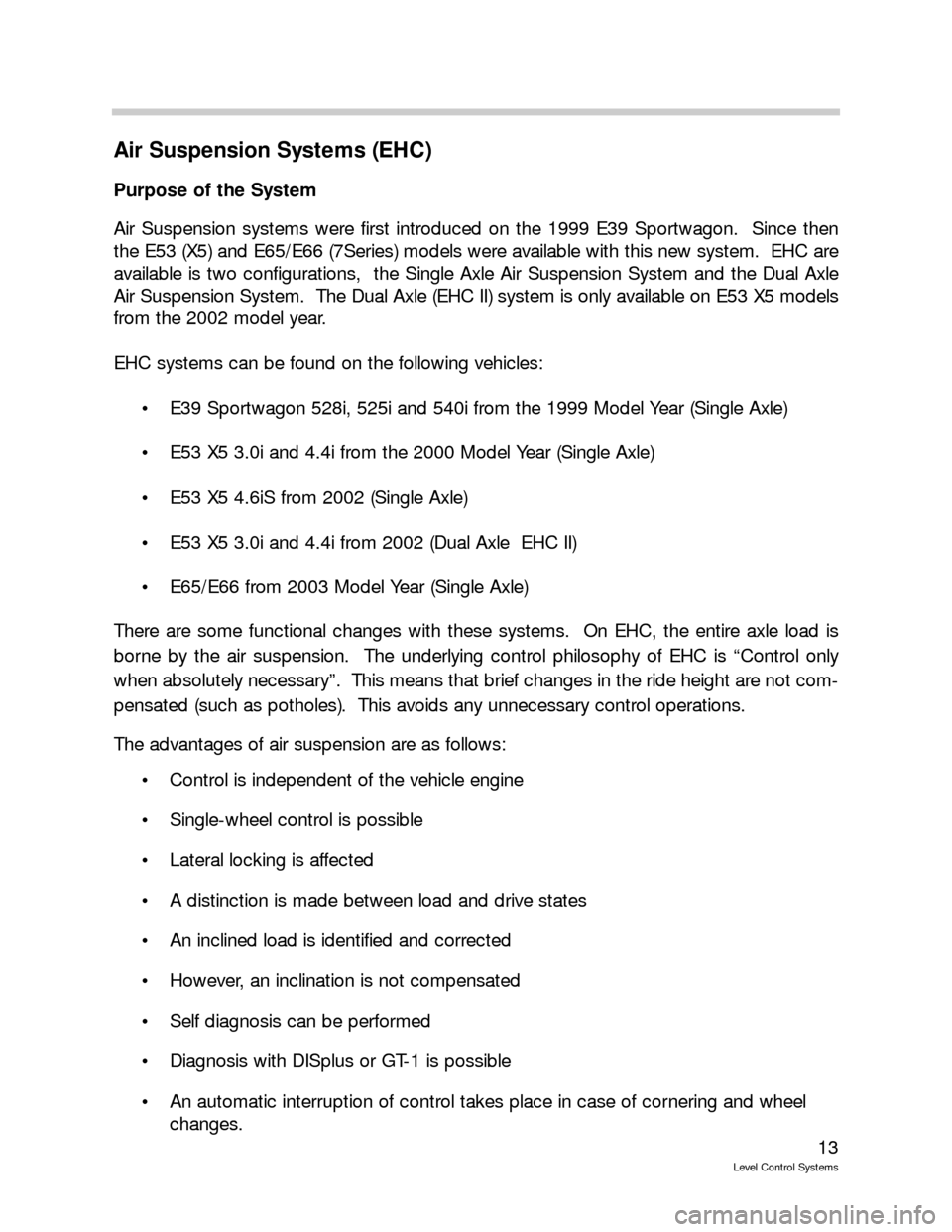Page 9 of 57
9
Level Control Systems
Control Valve
The rotary control valve located on the rear suspension has three positions:
Raise
Level
Lower
The control lever is attached to the rear stabilizer bar to sense vehicle loading. When the
vehicle is loaded (passenger or luggage) the suspension drops and the stabilizer bar twists.
The control lever is moved in the "raise" direction.
With the engine running, oil flows from the pump to the bottom of the rear struts. The body
of the car is lifted and the control lever returns to the level position.
In the level position, the oil
bypasses the valve and
returns to the reservoir
through the return line.
A minimum pressure of
440 Psi (30bar) is main-
tained at all times. If ser-
vice is required, a bleed off
valve is installed on the
control valve to drain the
systems pressure.
Page 10 of 57
10
Level Control Systems
Rear ShocksWith Load Dependent Module (LAD)
E32/E34 Rear Shock
with LAD
E38 Rear Shock
with LAD
Pressure
Reservoir
Connection
LAD Housing
Valve
Housing
Control
Piston
Pressure
Reservoir
Connection
LAD Housing
Page 11 of 57
11
Level Control Systems
LAD Module
With a high pressure applied to the control piston,
the flow resistance is high and the damping force
will be stiff.
The load dependent module is a control valve
that regulates the flow of oil between the strut
and the pressure reservoir.
The control piston in the (LAD) moves in rela-
tion to the pressure applied from the pump.
This movement will regulate the tension on the
inner spring of the module. With only a low
pressure applied, a small amount of tension
will be applied to the spring. Little flow resis-
tance will be developed between the strut and
pressure reservoir. The damping force is soft.
Page 12 of 57
12
Level Control Systems
Camber Warning Switch (E32 AND E34 Touring)
The self-leveling suspension systems used in the E32 and the E34 Touring are equipped
with a camber warning switch. The switch is mounted on the right rear axle support and
connected through a rod to the semi-trailing arm.
The function of the switch is to warn the driver of an
overload condition or an unsafe driving situation.
If the switch detects a rear wheel camber of -3.5 deg.
A signal is sent to the check control module and dis-
played on the dash.
A time delay of 8 minutes is incorporated to prevent
the warning from being displayed while driving
through turns.
The E38 does not use the camber warning switch
due to the design of the rear suspension.
Page 13 of 57

13
Level Control Systems
Air Suspension Systems (EHC)
Purpose of the System
Air Suspension systems were first introduced on the 1999 E39 Sportwagon. Since then
the E53 (X5) and E65/E66 (7Series) models were available with this new system. EHC are
available is two configurations, the Single Axle Air Suspension System and the Dual Axle
Air Suspension System. The Dual Axle (EHC II) system is only available on E53 X5 models
from the 2002 model year.
EHC systems can be found on the following vehicles:
E39 Sportwagon 528i, 525i and 540i from the 1999 Model Year (Single Axle)
E53 X5 3.0i and 4.4i from the 2000 Model Year (Single Axle)
E53 X5 4.6iS from 2002 (Single Axle)
E53 X5 3.0i and 4.4i from 2002 (Dual Axle EHC II)
E65/E66 from 2003 Model Year (Single Axle)
There are some functional changes with these systems. On EHC, the entire axle load is
borne by the air suspension. The underlying control philosophy of EHC is “Control only
when absolutely necessary”. This means that brief changes in the ride height are not com-
pensated (such as potholes). This avoids any unnecessary control operations.
The advantages of air suspension are as follows:
Control is independent of the vehicle engine
Single-wheel control is possible
Lateral locking is affected
A distinction is made between load and drive states
An inclined load is identified and corrected
However, an inclination is not compensated
Self diagnosis can be performed
Diagnosis with DISplus or GT-1 is possible
An automatic interruption of control takes place in case of cornering and wheel
changes.
Page 14 of 57
14
Level Control Systems
EHC System Overview
EHC I Single Axle Air Suspension E39/E53
EHC II Dual Axle Air Suspension E53
1. Air Supply Unit
2. Rear Axle Air Bellows
3. Ride Height Sensors
4. Pressure Accumulator/
Valve Unit
5. Front Axle Air Bellows
6. Control Unit
Page 15 of 57
15
Level Control Systems
Single Axle EHC I System Components (E39/E53)
The EHC system consists of the following components:
EHC Control Module
Air Springs (2) with Air Reservoirs
Rear Axle Level Sensors
Encapsulated Air Supply (LVA)
Warning Indicator
Control Module
The Control Module is mounted in the module carrier box in the luggage compartment on
the right side. It contains the processing electronics and final stages for operation of the
EHC system.
The control module receives the following inputs for its processing functions:
KL 30 & 31 (Power/Ground)
KL 15
Left & Right Ride Height Sensors
K Bus for;
- Vehicle speed
- Engine running
- Door/tailgate - open/closed
E39 Features 06
EHC Module (E39)
Page 16 of 57
16
Level Control Systems
The control module incorporates two filters (slow/rapid) for processing the input signals
from the ride height sensors. Depending on the operating mode, either the slow or rapid fil-
ter is used to check the need for a regulating sequence.
The slow filter is used during the normal operation mode to prevent normal suspension trav-
el from causing the system to make adjustments.
The rapid filter is used during the pre-run and tailgate (LID) modes to ensure that the sus-
pension is adjusted quickly while the vehicle is being loaded or checked prior to operation.